|
The Museum of Time
by Bob
Brooke
Time is an elusive
thing. It comes and goes incessantly, perhaps that’s why man
invented clocks and watches—to control it. From the earliest sun
dials to today’s digital timepieces, man has strived to keep track
of time. But for all the timepieces in the world, time still slips
away.
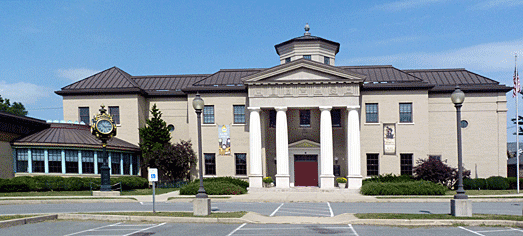
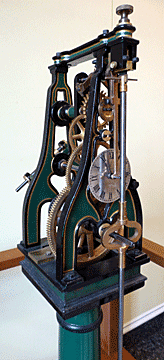 The
National Watch and Clock Museum in the sleepy town of Columbia,
Pennsylvania, preserves timepieces that have existed through time.
Officially opened in 1977 with less than 1,000 items, its collection has
grown to over 12,000. Here, you’ll find the largest and most
comprehensive horological collection in North America, including a large
collection of 19th-century American clocks and watches. But the museum
also displays an array of early English tallcase clocks, Asian
timepieces, and timekeeping devices from Germany, France, the
Netherlands, and Russia. Its exhibits take you on a chronological tour
through the entire history of timekeeping. The
National Watch and Clock Museum in the sleepy town of Columbia,
Pennsylvania, preserves timepieces that have existed through time.
Officially opened in 1977 with less than 1,000 items, its collection has
grown to over 12,000. Here, you’ll find the largest and most
comprehensive horological collection in North America, including a large
collection of 19th-century American clocks and watches. But the museum
also displays an array of early English tallcase clocks, Asian
timepieces, and timekeeping devices from Germany, France, the
Netherlands, and Russia. Its exhibits take you on a chronological tour
through the entire history of timekeeping.
Your journey through time begins as you walk through a narrow gallery
filled with examples of the best timekeeping devices in history. At the
end of the passageway stands a sun dial, one of the first.
Beyond in an assortment of galleries, you’ll find everything from the
basic technologies of the mechanical timekeeper, such as the pendulum,
and a large and varied exhibit on many types of clock escapement to fine
examples of American-made tall case clocks, commonly known as
“grandfather clocks."
The museum has devoted several galleries to a comprehensive exhibit on
American watches. Here, you’ll learn about the machinery used in watch
manufacturing. Other highlights include an exhibit of the pioneering
automated machinery developed by the American Waltham Watch Company,
allowing for the first time to mass-produce watches using
interchangeable parts, plus a large selection of American pocket
watches.
Early Mechanical Timepieces
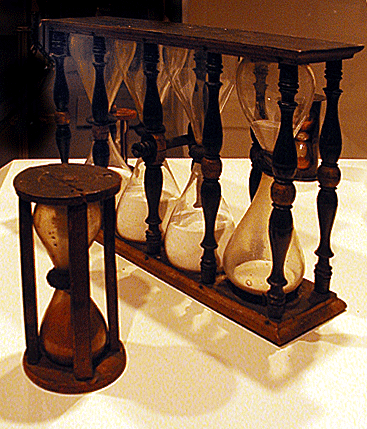 The
first gallery after the sundials shows a diorama of an 18th-century
clockmaker’s work area. The standard clock produced in the colonies
during the 18th century was a brass-movement tallcase clock. It took a
seven-year apprenticeship to learn all the skills necessary to make
these clocks. The clockmaker back then was a one-man operation. He did
everything. The
first gallery after the sundials shows a diorama of an 18th-century
clockmaker’s work area. The standard clock produced in the colonies
during the 18th century was a brass-movement tallcase clock. It took a
seven-year apprenticeship to learn all the skills necessary to make
these clocks. The clockmaker back then was a one-man operation. He did
everything.
As clockmakers became more numerous and specialized skills more diverse,
clocks were more and more frequently the product of collective labor. A
brass and lead founder cast parts of the movement, pendulum, and the
weights. A bell founder cast the resonant tone into the metal. A brazier
made the sheet metal of the dial. A die maker cut the screws; a spring
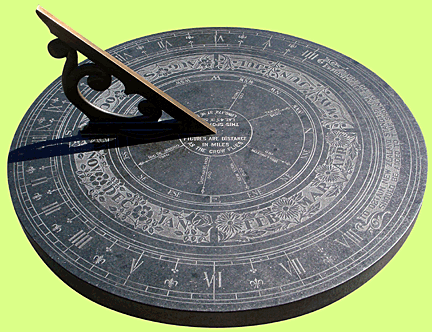 maker
produced the springs that allowed the lever in the movement to perform;
and a blacksmith made iron fasteners like nails and pins. maker
produced the springs that allowed the lever in the movement to perform;
and a blacksmith made iron fasteners like nails and pins.
Even the most self-sufficient clockmakers rarely did their own casework
as cabinetmaking was a separate craft. Cabinetmakers constructed cases
in size, fashion, and ornamentation to suit the buyer and his
pocketbook. You’ll admire all the beautiful clock cases along the walls.
The Beginnings of the American
Clockmaking Industry
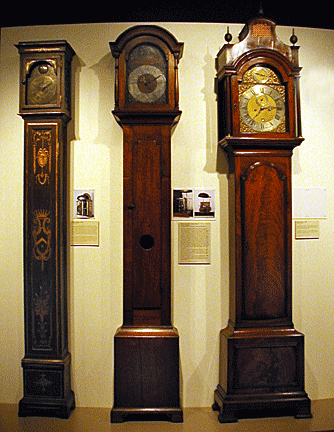 The
industry received a much-needed boost with the introduction in 1839 of
an inexpensive brass movement shelf clock by Chauncey Jerome of Bristol,
Connecticut. The next couple of galleries display a dazzling assortment
of 19th-century shelf and wall clocks. Here you’ll a collection of
imported cuckoo clocks, some bigger than you ever imagined, with relief
carvings of rabbits and squirrels and such. The so-called “Hunter”
clocks are the most elaborate. The
industry received a much-needed boost with the introduction in 1839 of
an inexpensive brass movement shelf clock by Chauncey Jerome of Bristol,
Connecticut. The next couple of galleries display a dazzling assortment
of 19th-century shelf and wall clocks. Here you’ll a collection of
imported cuckoo clocks, some bigger than you ever imagined, with relief
carvings of rabbits and squirrels and such. The so-called “Hunter”
clocks are the most elaborate.
On a far wall is a display of hauntingly beautiful Morbier clocks. These
unique clocks—also called “Wag-on-the-Wall” clocks had large, ornate
brass, paddle-like pendulums and could be hung on the wall without a
case. Cases for them were usually made by coffin makers, thus the name
Morbier, which means death in French.
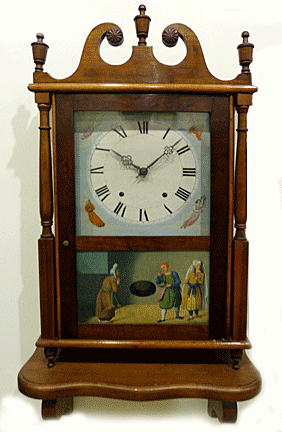 It
wasn’t until the development of less expensive coiled springs in the
1860s that spring clocks became popular. These clocks could be made much
smaller since long cases for weights weren’t necessary. It
wasn’t until the development of less expensive coiled springs in the
1860s that spring clocks became popular. These clocks could be made much
smaller since long cases for weights weren’t necessary.
By the end of the Civil War, many clock companies went out of business,
leaving seven major ones--- Ansonia Clock Company, New haven Clock
Company, Seth Thomas Clock Company, the Waterbury Clock Company, the
William L. Gilbert Clock Company, and the E.N. Welch Manufacturing
Company. Examples of clocks from all of these companies are on display.
You’ll also see elaborate frame clocks and clocks with reversed painted
doors. One of the most popular clocks in the early 19th century was the
banjo clock.
The Creation of Standard Time
Nothing in timepiece history is more significant than the creation of
Standard Time. In 1830, only 23 miles of railroad track existed the
entire United States. Fifty years later there were over 100,000. When
the railroads stretched west, a serious problem arose. Towns across the
country set their clocks by Noon local time. But each town experienced
Noon at a different time. Something had to be done to coordinate the
railroad timetables. The solution was to create time zones across the
U.S. An exhibit shows you exactly how that was accomplished.
A Look at American Watchmaking
Although a few colonists brought watchmaking skills, tools, and
materials from Europe as early as the late 17th century, most of them
sold and repaired imported watches rather than make new ones. The
American watchmaking industry began with Thomas Harland of Norwich,
Connecticut, who made the first American watch in the 1770s..
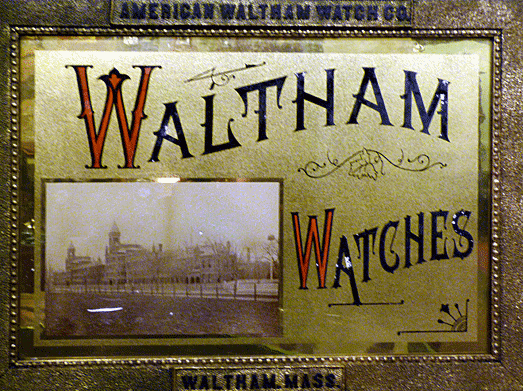
But it wasn’t until Aaron L. Dennison and Edward Howard successfully
produced watches by machine in the 1840s that the industry got fully
underway. With Howard's support, Dennison began developing the necessary
machinery in 1849, and only a few years later was having success with a
36-hour watch. Their firm, the Boston Watch Company, eventually became
the Waltham Watch Company. Exhibits and dioramas show how automation
transformed the watch industry.
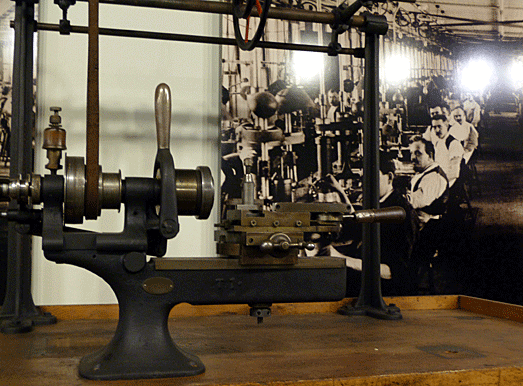
One of the most fascinating exhibits is a reproduction of a Victorian
clock and watch shop, complete with counter displays and a fully
equipped watch bench, which hasn’t change much today. Beautifully
crafted pocket watches line the display cases. And display
advertisements for Waltham and Waterbury Watches sit atop the counters.
High above is a display of fancy Victorian kitchen clocks.
The Marine Chronometers Gallery
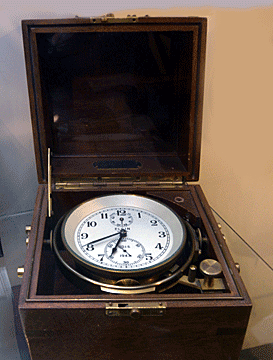 John
Harrison discovered a practical method of finding longitude with his
prizewinning chronometer in 1759, but his complex and delicate design
couldn’t be reproduced cheaply enough to make it practical. John
Harrison discovered a practical method of finding longitude with his
prizewinning chronometer in 1759, but his complex and delicate design
couldn’t be reproduced cheaply enough to make it practical.
Armold and Earnshaw were the first to show that quality sea clocks could
be produced in quantity, and by the end of the 18th century, standard
movements were being produced by cottage industry methods in England.
Eventually, England became the world leader in marine chronometers. A
small display of 18th and 19th-century chronometers shows the fine
craftsmanship that went into making them.
Clocks in Motion
During the 19th century, as more and more people began to travel by
carriage, they needed timepieces that could travel with them. One such
timepiece was the carriage clock, whose remarkably shockproof movement
was perfected by the French watchmaker Abraham Louis Brequet in the late
18th century.
Superb examples show just how luxurious they could be.
Clocks as Entertainment
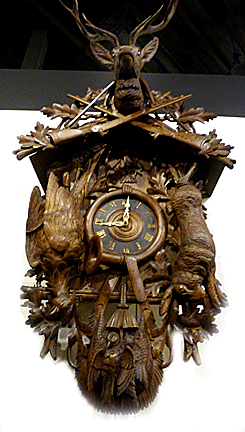 Although
the primary purpose of clocks is to tell time, it isn’t necessarily the
only purpose. Many clocks have been designed to dazzle, entertain, and
advertise products and services. The fronts of the doors of wall clocks
were a space that filled a need. It allowed businesses to display an ad
that could be viewed by many people. Most of the clocks on display would
have hung in shops, restaurants, banks, and other businesses where many
people could see them. Although
the primary purpose of clocks is to tell time, it isn’t necessarily the
only purpose. Many clocks have been designed to dazzle, entertain, and
advertise products and services. The fronts of the doors of wall clocks
were a space that filled a need. It allowed businesses to display an ad
that could be viewed by many people. Most of the clocks on display would
have hung in shops, restaurants, banks, and other businesses where many
people could see them.
Watches could also be used for entertainment. It wasn’t until the
mid-20th century that character watches became popular. With the advent
of television, watches featuring characters from popular T.V. shows
appeared in stores. Watch displays featuring Roy Rogers, Gene Autry,
Hopalong Cassidy—all western T.V. heroes—are as fascinating as the
watches, themselves.
The Eighth Wonder of the World
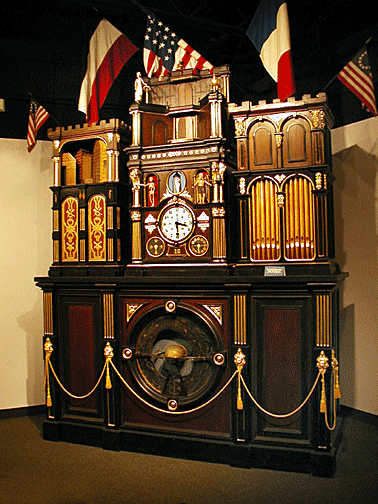 The
Engle Clock, a monumental clock made over two decades by Stephen D.
Engle of Hazelton, Pennsylvania, is by far the museum’s premier exhibit.
The purpose of this large, complicated, and painstakingly handcrafted
clock wasn’t so much to tell time as it was to awe and entertain.
Between 1875 and 1900, more than two dozen such creations toured the
United States and Europe, amusing and amazing crowds. Philadelphia
entrepreneurs Captain and Mrs. Jacob Reid called Engle's clock "The
Eighth Wonder of the World." They exhibited the clock throughout the
Eastern U.S., charging 25- and 15-cent admissions for adults and
children, respectively. The
Engle Clock, a monumental clock made over two decades by Stephen D.
Engle of Hazelton, Pennsylvania, is by far the museum’s premier exhibit.
The purpose of this large, complicated, and painstakingly handcrafted
clock wasn’t so much to tell time as it was to awe and entertain.
Between 1875 and 1900, more than two dozen such creations toured the
United States and Europe, amusing and amazing crowds. Philadelphia
entrepreneurs Captain and Mrs. Jacob Reid called Engle's clock "The
Eighth Wonder of the World." They exhibited the clock throughout the
Eastern U.S., charging 25- and 15-cent admissions for adults and
children, respectively.
This towering mechanical clock toured over 70 years until it disappeared
after a 1951 showing at the Ohio State Fair. Members of the National
Association of Watch and Clock Collectors spent years searching for it
and after tracking it down were able to acquire it in 1988. Museum staff
and volunteers spent hours and hours restoring it to its original
working condition.
The clock's eclectic gathering of moving figures include Jesus Christ,
the twelve Apostles, the three Marys, Satan, Father Time, the three Ages
of Man, Death, Justice, Orpheus, and Linus. A depiction of Continental
soldiers marching past Molly Pitcher on their way to the Battle of
Monmouth adds a distinctly American dimension to the clock. A figure of
Stephen Engle himself functions as an animated signature of the clock's
maker. You can watch this amazing clock in action during designated
“show” times throughout the day.
The museum is quite large, so allow at least two to three hours to fully
take in all it has to offer.
<
Back to More Antiques to View
Next Article >
|
